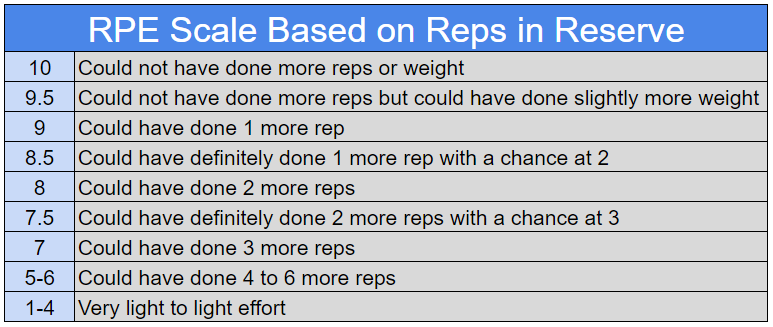Word Count: 1,486
Average Read Time: 5.5 minutes
Note: The text and audio for this post were adapted from a YouTube video. If you’d like to watch the original video, click here.
Do you want to know how to get better results in the gym? Let’s talk about how to do that with a tool named the RPE scale. The RPE scale is an extremely valuable tool for selecting weights for any exercise at any number of reps. RPE stands for rate of perceived exertion. In other words, how hard was the set you just completed?
RPE Scale
I’m going to walk you through the RPE scale, I’ll give you a couple of examples using the RPE scale, I’ll give you my advice for using RPE as a beginner, I’ll cover a couple of frequently asked questions, and lastly, I’ll go over the benefits and drawbacks of using the RPE scale.
Let’s let’s take a look at the RPE chart. The modern form of the RPE chart was developed by Mike Tuchscherer and is based on how many reps away from failure you were at the end of your set. This is also known as reps in reserve.
RPE 10 is an absolute max effort. You completed all of the required reps, but you could not have done another rep nor could you have done more weight.
RPE 9.5 means you probably couldn’t have completed another rep but you might have been able to do slightly more weight.
RPE 9 means you could have done one more rep
RPE 8.5 means you definitely could have done one more rep, possibly two.
RPE 8 means you could have done two more reps.
So on and so forth until we get down to RPE 6.
Everything under RPE 6 counts as a warmup.
If you’ve already done an exercise before, you can look back at how much weight you did and how hard you said that set was. You can then gauge how much weight to do based on the last time you did the exercise.
For example, let’s say last week you deadlifted 405 pounds for 3 sets of 3 reps and your RPE target was between 7-9, so you wanted to be 1-3 reps from failure. You called the first set a 7, the second set a 7.5, and the third set a 7.5.
This week you have to do 3 sets of 2 reps. You look back at your workout log and can see last week was pretty easy and you’re also doing 1 less rep this week. You can say based on that, you’re going to do your first set with 415.
Now let’s do a similar example. Let’s say you did barbell overhead press last week with 135 lbs for 3 sets of 5 reps and your RPE target was again 7-9. You called the first set a 7.5, the second set an 8.5, and on the last set, you barely squeezed out that last rep, but it was your max effort and was an RPE value of 10.
This week you have barbell overhead press again, but at 3 sets of 4 reps. You look back at last week’s workout and see that 135 pounds was a bit too heavy for you, so you decide to start with 135 pounds again this week since you’re doing one less rep per set.
You may have noticed the RPE recommendations in these examples were given as a range instead of one specific number to hit. This is to account for fatigue that accumulates with each additional set. In other words, if your first set is an RPE 7, given appropriate rest periods, there’s a good chance your third set will be an RPE 9.
The question you’re probably asking at this point is why not just train to failure? There’s actually a limited amount of data comparing training to failure vs training near failure. Out of the six studies I found, three showed greater muscle growth when training to failure. With half the studies showing better results with failure training, you’re probably still asking why not just train to failure.
The answer is simple. While failure training may or may not have a slight positive impact on short-term muscle growth, it definitely has a major negative impact on recovery, which would negatively impact your ability to stick to your program, which in turn would negatively impact long-term results.
I’ll cover when and how to incorporate failure training in a future video, but for now, the question is, how close to failure should we train to get the best results without sacrificing recovery?
Based on the limited amount of data available and the expert opinions of Dr’s. Eric Helms and Mike Zourdos, you should aim for an RPE of 6-8 on complex exercises such as squats and deadlifts, to avoid the need to reduce weight as you perform additional sets and an RPE of 8-10 on simpler exercises with a lower risk of injury, such as bicep curls and tricep extensions.
How to Select Weight
Now that we’ve covered how the RPE scale works, let’s talk about how to select weights. If you’re a beginner or if you’re trying a new exercise for the first time, you likely won’t know how much weight to lift for said exercise.
If this is the case, select a weight you know for certain you can easily do and use it as a warm up. Use the difficulty of the warmup set to gauge how much weight to increase for the second set. If the second set was still too easy, count it as another warm up and increase the weight again. Repeat this process until you find a weight that puts you at the appropriate RPE and count it as your first working set.
This brings us to the first drawback of the RPE scale. If you’re a beginner, you won’t know what it feels like to take a set all the way to failure, therefore, you can’t accurately assess how far you are away from failure.
That said, I still think RPE is a valuable tool for beginners and with a little bit of practice, you’ll be skilled at using the RPE scale in no time. I actually have all of my clients using the RPE scale. I don’t expect them to be good at using it at first, but I have them use it as soon as they start so they can practice using it.
The other drawback to the RPE scale is the more reps you do per set, the less accurate it is. From my experience, as you exceed around 20 reps, the RPE scale becomes fairly unreliable. This is because as reps increase, more factors than just muscular fatigue set in, such as cardiovascular fatigue and mental fatigue. Because of this, you might end a set thinking you were 2 reps away from muscular failure and call that set an RPE 8, when in reality, you may have ended the set due to mental fatigue. If someone were standing there watching you, you might have been able to crank out 5 or 6 more reps.
That said, there’s one major benefit to the RPE scale that makes it worth using. RPE takes into account how you’re feeling on any given day, whether good or bad. For example, if your program simply says do 3 sets of 5 on bench press with 225 pounds, you may go in on a day that you’re exhausted and hit failure on all 3 sets and not get the required reps because you’re trying to use the weight that your program says.
If you had been using RPE, you could have adjusted the weight down to 215 or 210 and gotten all of the required reps. On the other hand, you may go in the gym with more energy than usual one day, but you do 3 sets of 5 with only 225 because that’s what your program said to do. If the program had said do 3 sets of 5 @ RPE 7-9, you might have gotten 235 pounds for 3 sets of 5.
While RPE can be an extremely useful tool, there’s one final note I would like to leave you with. When using RPE, you MUST be honest with yourself. I’ve seen people barely grind out their last rep and call it an RPE 7 and I’ve seen people not even struggle on a set and call it an RPE 10. A great program will not get you the results you want if you do it incorrectly.
Thank you so much for reading! If you found this information helpful and want to help the Treadaway Training blogcast grow, simply share this post with a friend. If you like what I have to say, sign up below to become a Treadaway Training insider and get notified for each blogcast and video. I will be back here Thursday with another fat loss topic. As always, God bless you AND your family and I'll see you Thursday.







